Exploring New Avenues in Sustainable Urban Development: Ecological Carbon Dynamics of Park City in Chengdu
Abstract
1. Introduction
2. Research Methodology
2.1. Study Area
2.2. InVEST Model
2.3. FLUS Model
2.3.1. Probability Estimation of Suitability
2.3.2. Adaptive inertia Coefficient
2.3.3. Precision Validation
2.3.4. Geographic Detector
2.3.5. Scenario-Based Land Use Prediction
3. Results and Analysis
3.1. Land Use Change
3.1.1. Spatial and Temporal Land Use Change Characteristics
3.1.2. Transformation of Land Use in Chengdu from 2012 to 2022
3.1.3. Multi-Scenario Simulation of Future Land Use
3.2. Carbon Stock Changes
3.2.1. Spatial and Temporal Characteristics of Carbon Stock
3.2.2. The Impact of Park City Construction on Carbon Stock
3.2.3. Future Changes in Carbon Stock under Different Scenarios
3.2.4. Carbon Stock Driving Mechanisms
4. Discussion
4.1. Reasons for Changes in Carbon Stock in Chengdu
4.2. Research Challenges and Uncertainties
- Park City construction should be continued. Practice has shown that the construction of the Park City can optimize the structure of land use and improve the quality of ecological land use. In the PCS, carbon stock is higher than in other scenarios, which can help mitigate the loss of urban carbon stock and promote the achievement of the carbon peaking and carbon neutrality goals.
- Strengthen ecological restoration efforts, especially in controlling the use of ecological land. By continuous ecological restoration, enhance the ecological quality of forest and grassland, and fully utilize their carbon sequestration function.
- Emphasize the protection of water areas. Restoring damaged aquatic ecosystems through ecological restoration projects, including vegetation recovery and wetland restoration, can enhance the carbon stock capacity of water areas. Rehabilitating healthy aquatic ecosystems contributes to improving carbon sequestration efficiency.
- Strictly control the conversion of construction land. Clearly define the boundaries between ecological land and construction land, and strictly control the scope and speed of land conversion for construction. Simultaneously, promote green building and low-carbon urban development to reduce the impact of construction land on the ecological environment.
4.3. The Practical Significance of Park City Construction
5. Conclusions
Author Contributions
Funding
Institutional Review Board Statement
Informed Consent Statement
Data Availability Statement
Conflicts of Interest
References
- Wang, B.; Mu, C.C.; Lu, H.C.; Li, N.; Zhang, Y.; Ma, L. Ecosystem carbon stock and sink/source of temperate forested wetlands in Xiaoxing’anling, northeast China. J. For. Res. 2022, 33, 839–849. [Google Scholar] [CrossRef]
- Fowzia, A.; Erika, M.; Adam, C.; Tsedekech, G.W.; Csaba, G.; Melenya, O.C.; Evans, D.; Stephen, O.; Marta, F. Effects of land use change and topography on the quantity and distribution of soil organic carbon stocks on Acrisol catenas in tropical small-scale shade cocoa systems of the Ashanti region of Ghana. Catena 2022, 216, 106366. [Google Scholar]
- Wang, Q.; Yang, C.H.; Wang, M.L.; Zhao, L.; Zhao, Y.C.; Zhang, Q.P.; Zhang, C.Y. Decoupling analysis to assess the impact of land use patterns on carbon emissions: A case study in the Yellow River Delta efficient eco-economic zone, China. J. Cleaner Prod. 2023, 412, 137415. [Google Scholar] [CrossRef]
- Nave, L.E.; DeLyser, K.; Domke, G.M.; Holub, S.M.; Janowiak, M.K.; Keller, A.B.; Peters, M.P.; Solarik, K.A.; Walters, B.F.; Swanston, C.W. Land use change and forest management effects on soil carbon stocks in the Northeast U.S. Carbon Balance Manag. 2024, 19, 5. [Google Scholar] [CrossRef] [PubMed]
- Qu, S.J.; Han, L.; Huang, X.; Yang, N.N.; Guo, Q.H. Analysis of the spatiotemporal evolution of carbon reserves in Shanxi province under different scenarios in the future. Environ. Sci. 2023, 1–20. [Google Scholar] [CrossRef]
- Sun, L.Q.; Chen, J.; Li, Q.L.; Huang, D. Dramatic uneven urbanization of large cities throughout the world in recent decades. Nat. Commun. 2020, 11, 5366. [Google Scholar] [CrossRef] [PubMed]
- Zhen, J.C.; Xie, B.G.; You, X.B. Spatio-temporal characteristics of habitat quality based on land-use changes in Guangdong Province. Acta Ecol. Sin. 2022, 42, 6997–7010. [Google Scholar]
- Liang, G.M.; Xiao, Y.; Liu, M.M.; Lin, S.; Wu, Z.L.; Hu, X.S. Simulation and elicitation of land use and carbon stock changes in Fuzhou under the background of traffic planning. J. Nat. Resour. 2023, 38, 3074–3092. [Google Scholar]
- Li, B.B.; Li, P.P.; Yang, M.Y.; Xiao, H.B.; Xu, M.X.; Liu, G.B. Land-use conversion changes deep soil organic carbon stock in the Chinese Loess Plateau. Land. Degrad. Dev. 2021, 32, 505–517. [Google Scholar] [CrossRef]
- Zhu, G.F.; Qiu, D.D.; Zhang, Z.X.; Sang, L.Y.; Liu, Y.W.; Wang, L.; Zhao, K.; Ma, H.; Xu, Y.; Wan, Q. Land-use changes lead to a decrease in carbon stock in arid region, China. Ecol. Indic. 2021, 127, 107770. [Google Scholar] [CrossRef]
- Zhang, B.; Li, L.; Xia, Q.Y.; Dong, J. Land use change and its impact on carbon stock under the constraints of “three lines”: A case study of Wuhan City circle. Acta Ecol. Sin. 2022, 42, 2265–2280. [Google Scholar]
- Yang, X.L.; Xie, M.K.; Zhang, Y.L.; Liu, D.G. Influencing mechanism of urbanization on carbon stock in urban and rural ecological spaces: A case study of Beijing. J. Chin. Urban For. 2023, 21, 98–105+142. [Google Scholar]
- Fu, K.X.; Jia, G.D.; Yu, X.X.; Chen, L.X. Analysis of temporal and spatial carbon stock changes and driving mechanism in Xinjiang region by coupled PLUS-InVEST-Geodector model. Environ. Sci. 2024, 1–19. [Google Scholar] [CrossRef]
- Hersperger, M.A.; Oliveira, E.; Pagliarin, S.; Palka, S.; Verburg, P.; Bolliger, J.; Grădinaru, S. Urban land-use change: The role of strategic spatial planning. Glob. Environ. Chang. 2018, 51, 32–42. [Google Scholar] [CrossRef]
- Wu, J.J.; Tang, Z.F.; Lü, F.Z.; Yang, K.J. Ultrasonic guided wave focusing in waveguides with constant irregular cross-sections. Ultrasonics 2018, 89, 1–12. [Google Scholar] [CrossRef] [PubMed]
- Shi, T.M.; Wang, D.; Tang, Y.; Li, P.Y.; Chu, Y.Q. Research progress on calculation method and impact factors of carbon sequestration capacity in urban eco-systems. J. Appl. Ecol. 2023, 34, 555–565. [Google Scholar]
- Li, P.Y.; Wan, Q.Y. Current situation and reflection on the design of Dong’an Lake Park in Chengdu guided by the concept of Park City. Sichuan Arch. 2023, 43, 52–54. [Google Scholar]
- He, X.; Yin, F.; Wang, J.X. Research on the landscape planning path of carbon sequestration enhancement in the background of Park City—Taking Chengdu as an example. J. Environ. Ecol. 2024, 6, 31–36+58. [Google Scholar]
- Ren, D.Z.; Liao, X.Y.; Xiao, Q.G.; Lai, C.H.; Song, F.; Meng, S.M.; Peng, X.Q. Carbon stock and spatial distribution pattern of forest vegetation in Chengdu. J. West China For. Sci. 2021, 50, 74–81. [Google Scholar]
- Ji, B.; He, J.L.; Wang, Z.J.; Jiang, Q. Characteristics and composition of vegetation carbon stock in natural grassland in Ning-xia, China. J. Appl. Ecol. 2021, 32, 1259–1268. [Google Scholar]
- Guo, Y.; Wei, Y.Q.; Ouyang, C.Y. Research on LIM-based simulation of carbon stock baseline scenario in urban trees: Taking the green space of a university in Beijing as an example. Beijing For. Univ. 2022, 44, 111–120. [Google Scholar]
- Piao, S.L.; Fang, J.Y.; Ciais, P.; Peylin, P.; Huang, Y.; Sitch, S.; Wang, T. The carbon balance of terrestrial ecosystems in China. Nature 2009, 458, 1009–1013. [Google Scholar] [CrossRef] [PubMed]
- Zhao, S.Q.; Liu, S.G.; Sohl, T.; Young, C.; Werner, J. Land use and carbon dynamics in the southeastern United States from 1992 to 2050. Environ. Res. Lett. 2013, 8, 044022. [Google Scholar] [CrossRef]
- Zhao, H.F.; Li, X.D.; Zhang, D.; Xiao, R.X. Aboveground biomass in grasslands in Qinghai Province estimated from MODIS data and its influencing factors. Acta Pratacult. Sin. 2020, 29, 5–16. [Google Scholar]
- Zhang, X.C.; Zhu, H.Z.; Zhong, H.P.; Zhu, H.P.; Cheng, Y.D.; Jin, G.L.; Shao, X.M. Assessment of above-ground biomass of grassland using remote sensing, Yili, Xinjiang. Acta Pratacult. Sin. 2015, 24, 25. [Google Scholar]
- Xu, W.Y.; Jin, X.B.; Yang, X.H.; Wang, Z.Q.; Liu, J.; Wang, D.; Shan, W.; Zhou, Y. The estimation of forest vegetation biomass in China in spatial grid. J. Nat. Resour. 2018, 33, 1725–1741. [Google Scholar]
- Sui, Y.Z.; Sun, D.P.; Li, S.J.; Xu, Y.C.; Wu, J.J. Study of coastal zone ecosystem restoration in the context of carbon stock change: A case of Dongying City. Acta Ecol. Sin. 2021, 41, 8112–8123. [Google Scholar]
- Chen, X.; Yu, L.; Hou, S.; Liu, T.; Li, X.Y.; Li, Y.Y.; Du, Z.; Li, C.; Wu, H.; Gao, G.; et al. Unraveling carbon stock dynamics and their determinants in China’s Loess Plateau over the past 40 years. Ecol. Indic. 2024, 159, 111760. [Google Scholar] [CrossRef]
- Babbar, D.; Areendran, G.; Sahana, M.; Sarma, K.; Raj, K.; Sivadas, A. Assessment and prediction of carbon sequestration using Markov chain and InVEST model in Sariska Tiger Reserve, India. J. Cleaner Prod. 2021, 278, 123333. [Google Scholar] [CrossRef]
- Liu, X.P.; Liang, X.; Li, X.; Xu, X.C.; Ou, J.P.; Chen, Y.M.; Li, S.; Wang, S.; Pei, F. A future land use simulation model (FLUS) for simulating multiple land use scenarios by coupling human and natural effects. Landscape. Urban Plan. 2017, 168, 94–116. [Google Scholar] [CrossRef]
- Fang, Z.S.; Zhong, C.R.; Wang, F.X.; Cheng, C.; Lü, X.B.; Chen, X. Spatia-temporal evolution and prediction of ecosystem carbon stock on Hainan island by coupling InVEST and FLUS models. Bull. Soil Water Conserv. 2023, 43, 320–329+342. [Google Scholar]
- Shen, L.; Zeng, Q. Multiscenario simulation of land use and land cover in the Zhundong mining area, Xinjiang, China. Ecol. Indic. 2022, 145, 109608. [Google Scholar] [CrossRef]
- Zhang, Y. Study on Carbon Emission Effect in Chengdu Plain Area Based on LUCC. Master’s Thesis, Sichuan Normal University, Sichuan, China, 2018. Volume 5. p. 25. [Google Scholar]
- Xie, G.; Wu, L.P.; Chen, M. Characterization of the evolution of spatial and temporal patterns of carbon stock in Chengdu based on land use change. Environ. Impact Assess. 2023, 45, 104–112. [Google Scholar]
- Zhang, Y.; Yu, P.H.; Tian, Y.S.; Chen, H.T.; Chen, Y.Y. Exploring the impact of integrated spatial function zones on land use dynamics and ecosystem services tradeoffs based on a future land use simulation (FLUS) model. Ecol. Indic. 2023, 150, 110246. [Google Scholar] [CrossRef]
- Li, J.Y.; Gong, J.; Guldmann, J.; Li, S.C.; Zhu, J. Carbon dynamics in the northeastern Qinghai–Tibetan Plateau from 1990 to 2030 using Landsat land use/cover change data. Remote Sens. 2020, 12, 528. [Google Scholar] [CrossRef]
- Yao, L.J.; Yue, B.R.; Pan, W.T.; Zhu, Z.B. Spatio-temporal evolution and multi-scenario simulation of carbon stock in counties based on FLUS and InVEST models. J. Chin. Urban For. 2023, 21, 152–158. [Google Scholar]
- Meng, F.M.; Luo, M.; Sa, C.L.; Wang, M.L.; Bao, Y.H. Quantitative assessment of the effects of climate, vegetation, soil and groundwater on soil moisture spatiotemporal variability in the Mongolian Plateau. Sci. Total Environ. 2021, 809, 152198. [Google Scholar] [CrossRef] [PubMed]
- Yue, S.J.; Ji, G.G.; Chen, W.Q.; Huang, J.C. Spatial and temporal variability characteristics of future carbon stocks in Anhui province under different SSP scenarios based on PLUS and InVEST models. Land 2023, 12, 1668. [Google Scholar] [CrossRef]
- Wei, Z.Z.; Dong, B.; Xu, H.F.; Xu, Z.L.; Lu, Z.P.; Liu, X. Spatio-temporal evolution and scenario prediction of carbon stock in typical wetlands in the Poyang Lake region. Bull. Soil Water Conserv. 2023, 43, 290–300. [Google Scholar]
- Gong, S.X.; Zhang, Y.H.; Li, Y.H. Spatio-temporal variation and prediction of carbon stock in Beijing–Tianjin–Hebei region–A PLUS–InVEST model approach. J. Arid. Land. 2023, 37, 20–28. [Google Scholar]
- Xu, D.; Yu, C.Q.; Lin, W.P.; Yao, J.; Zhou, W.Y. Spatiotemporal Evolution and Prediction of Land Use and Carbon Stock in Shanghai. Land 2024, 13, 267. [Google Scholar] [CrossRef]
- Ji, M.; Liu, H.C.; Li, W.; Liu, C.C.; Wang, Y.J.; Zhang, L.; Deng, M.R.; Shen, X.Y.; Liu, L.J.; Pan, K.W. The present situation and strategies of the follow-up industry development of the defarming-and-reafforestation program in Chengdu city. J. Sichuan For. Sci. Technol. 2013, 34, 91–94. [Google Scholar]
- Zhao, T.; Meng, J.J. Spatio-Temporal Evolution of Land Use and Resulting change in Carbon Stock in chengdu Plain Economic Zone (CPEZ), China. Mtn Res. 2023, 41, 648–661. [Google Scholar]
- Wu, D.; Zhu, K.G.; Zhang, S.; Huang, C.G.; Li, J. Evolution Analysis of Carbon Stock in Chengdu-Chongqing Economic Zone Based on PLUS Model and InVEST Model. Ecol. Environ. Monit. Three Gorges 2022, 7, 85–96. [Google Scholar]
- Wang, Z.Y.; Wu, F.; Wan, D.; Zhang, K.; Li, L.B.; Huang, C.H. Multi-scenario simulation of the impact of regional land use change on carbon reserve. China Environ. Sci. 2023, 43, 6063–6078. [Google Scholar]


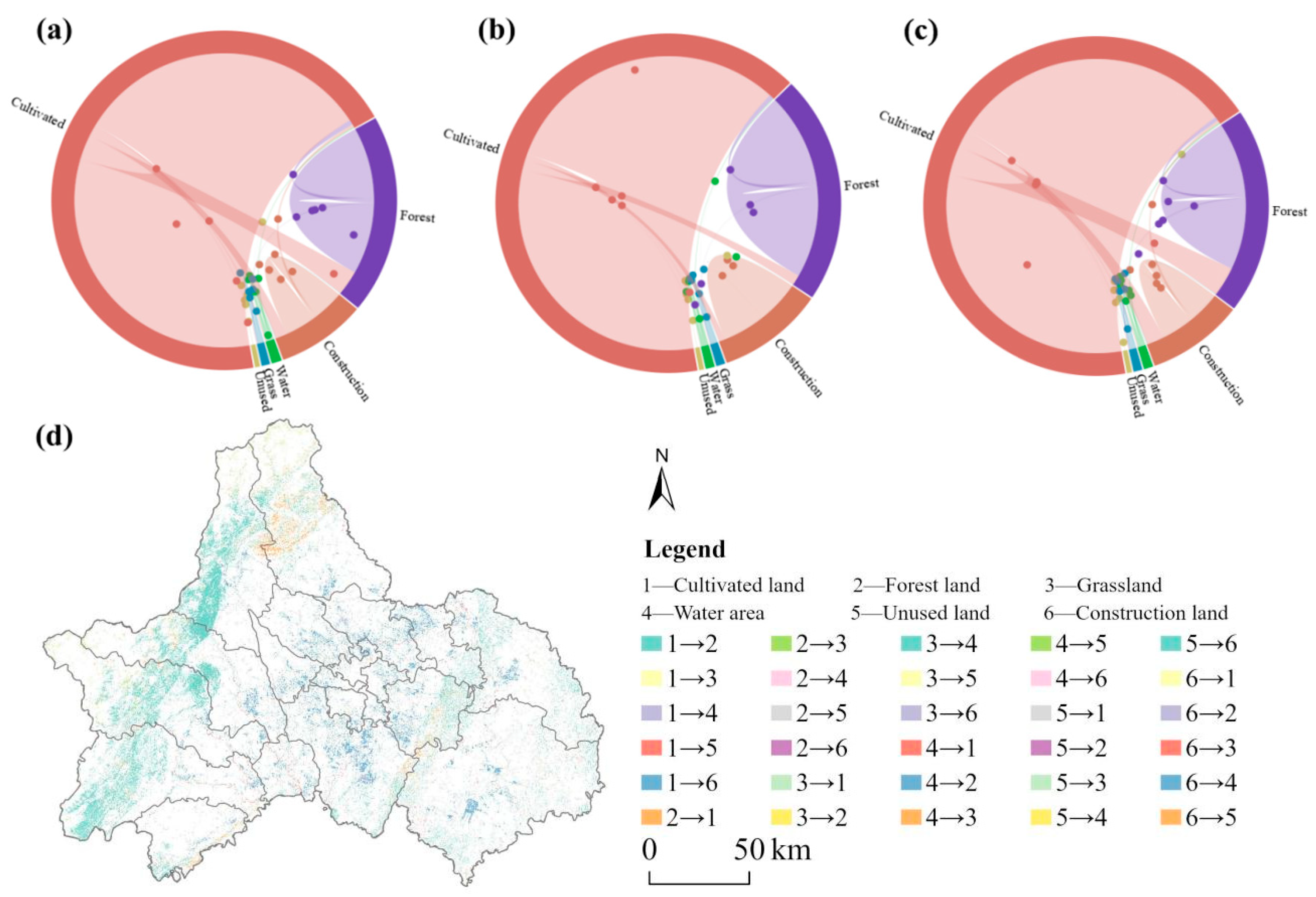



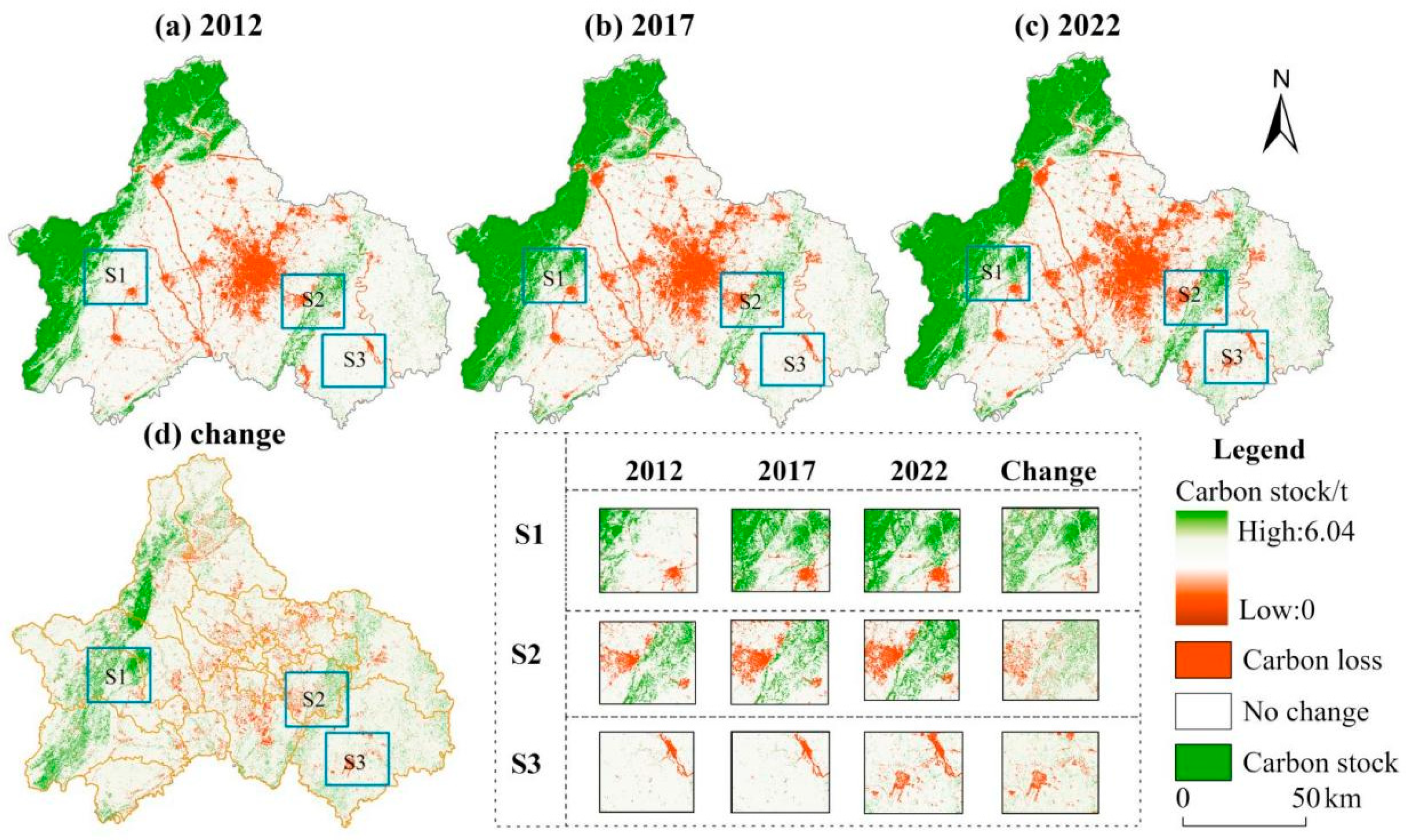
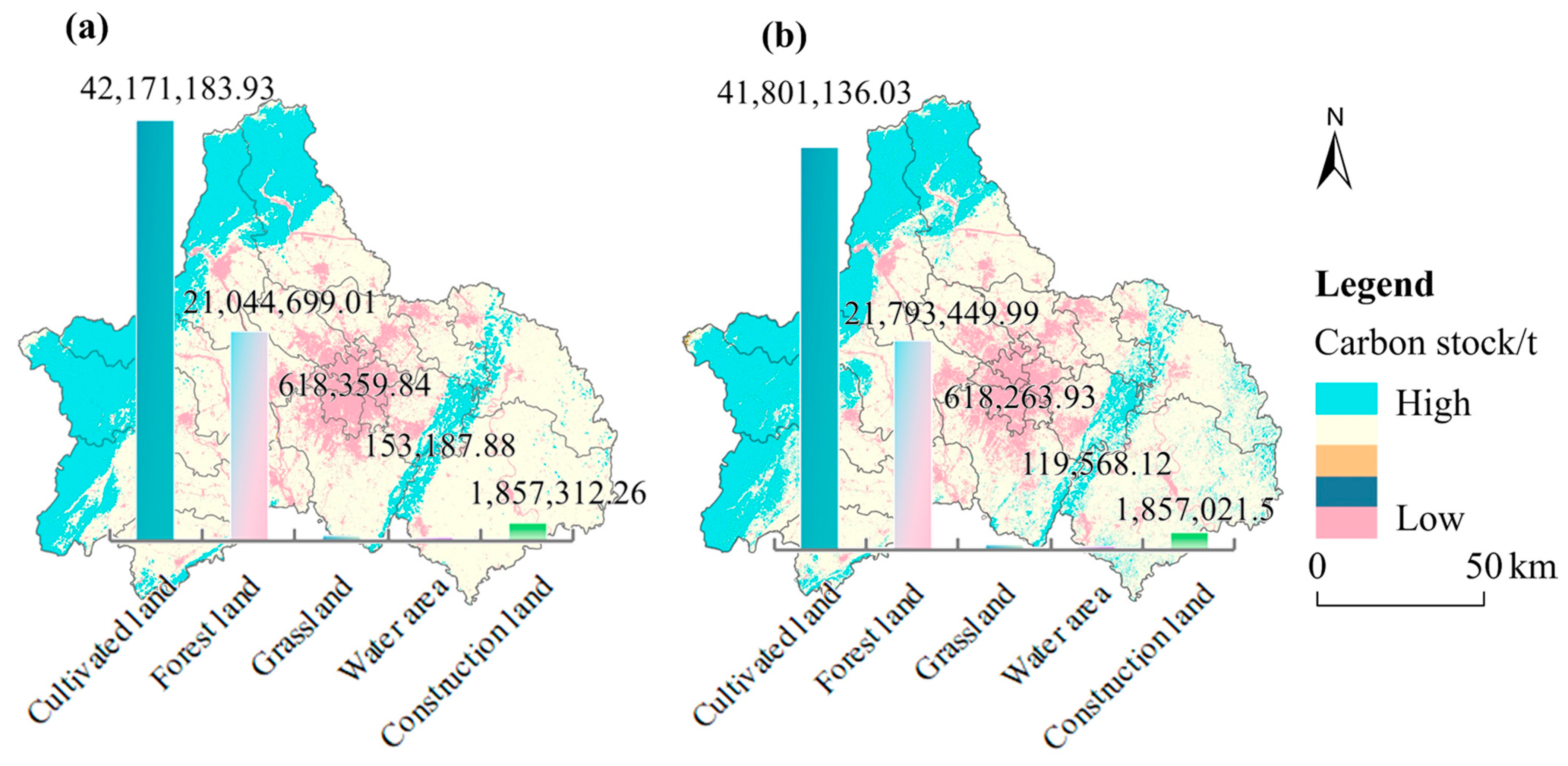

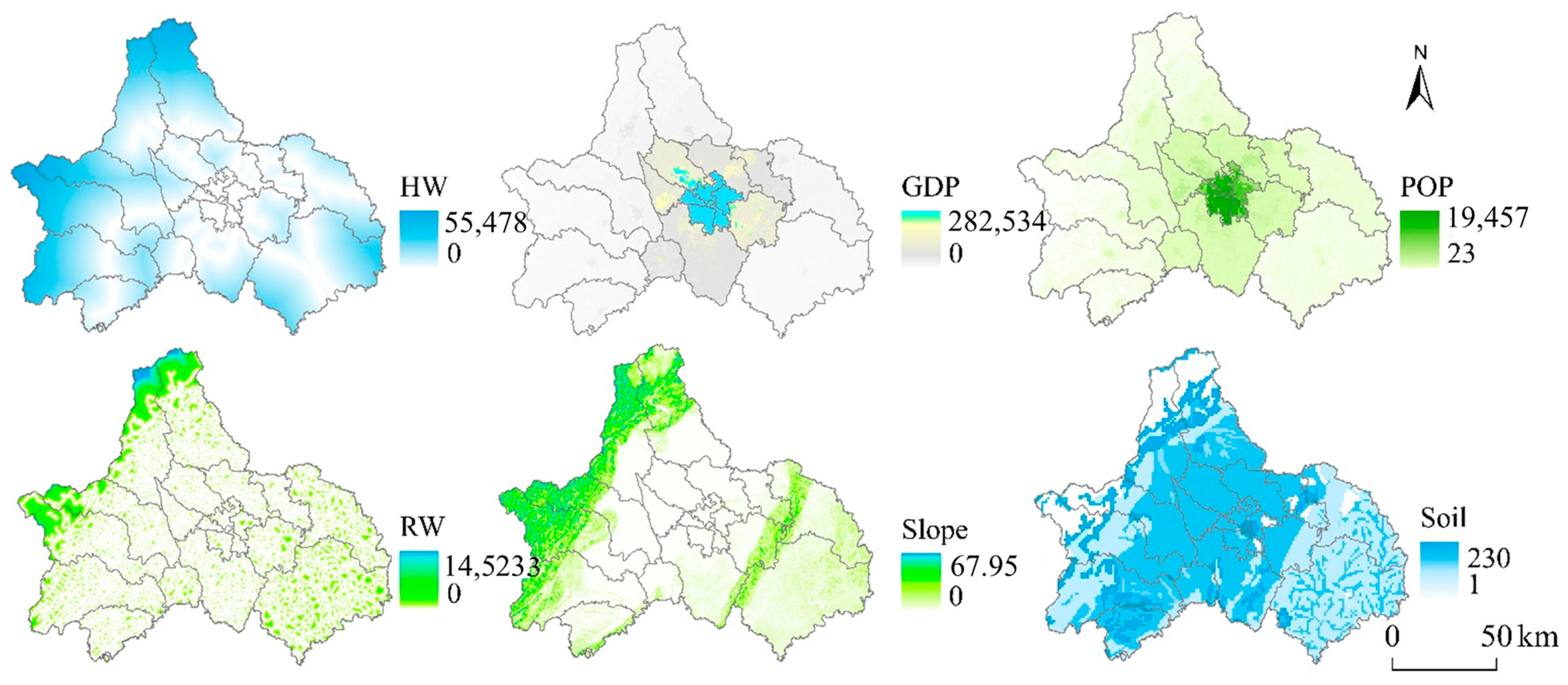
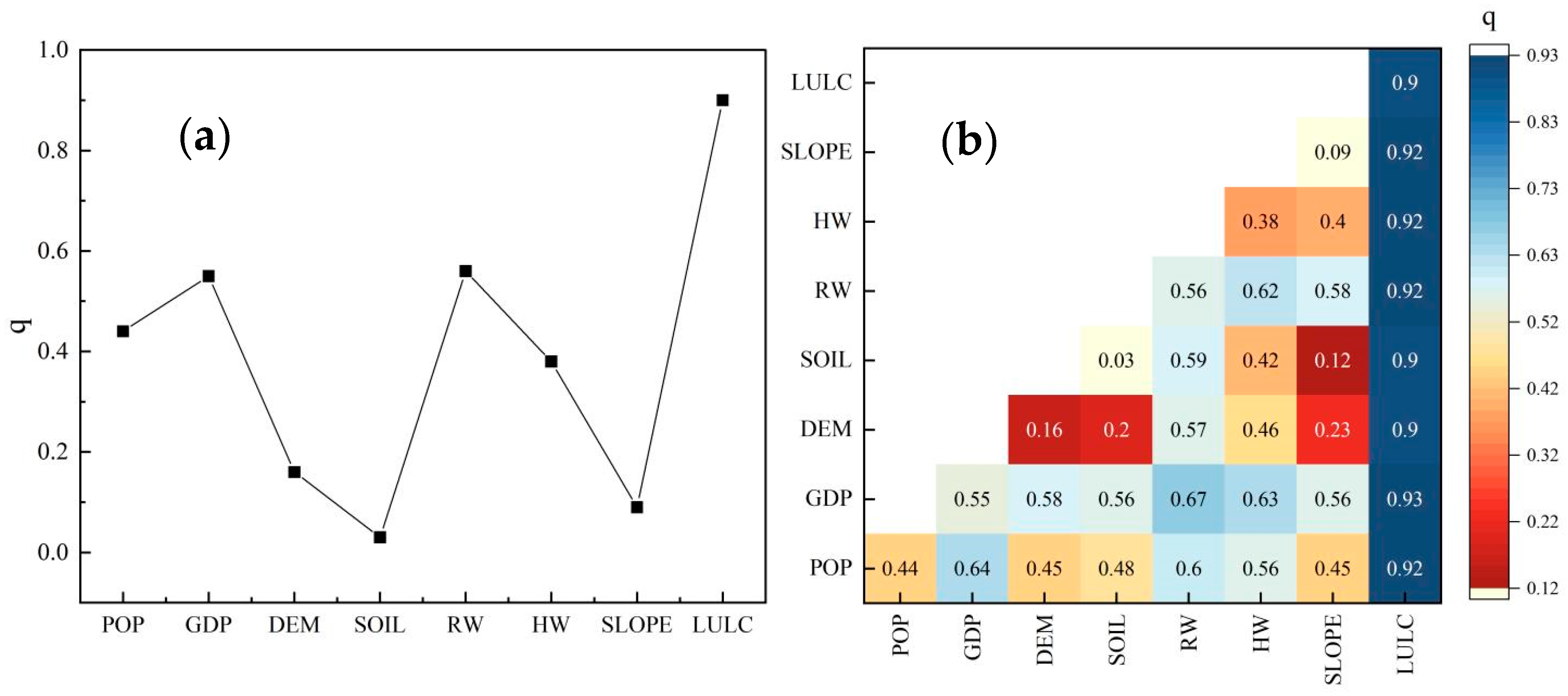
| Land Use Type | C_above | C_below | C_Soil | C_Dead |
|---|---|---|---|---|
| Cultivated land | 8.92 | 13.07 | 22.85 | 0.19 |
| Forest land | 12 | 14.87 | 32.81 | 7.413 |
| Grassland | 9.79 | 12.06 | 24.49 | 1.101 |
| Water area | 0 | 0 | 9.41 | 1 |
| Unused land | 0 | 0 | 0 | 0 |
| Construction land | 3.4 | 0 | 8.56 | 0 |
| Development Scenarios | Cultivated Land | Forest Land | Grassland | Water Area | Unused Land | Construction Land |
|---|---|---|---|---|---|---|
| NDS | 0.291 | 0.286 | 0.1 | 0.095 | 0.012 | 0.268 |
| CLDS | 0.231 | 0.326 | 0.12 | 0.095 | 0.012 | 0.248 |
| PCS | 0.291 | 0.296 | 0.1 | 0.095 | 0.012 | 0.248 |
| Development Scenarios | Land Use Type | Cultivated Land | Forest Land | Grassland | Water Area | Unused Land | Construction Land |
|---|---|---|---|---|---|---|---|
| NDS | Cultivated land | 1 | 1 | 1 | 1 | 1 | 1 |
| Forest land | 1 | 1 | 1 | 1 | 1 | 1 | |
| Grassland | 1 | 1 | 1 | 1 | 1 | 1 | |
| Water area | 0 | 0 | 0 | 1 | 0 | 0 | |
| Unused land | 1 | 1 | 1 | 1 | 1 | 1 | |
| Construction land | 0 | 0 | 0 | 0 | 0 | 1 | |
| CLDS | Cultivated land | 1 | 1 | 0 | 0 | 0 | 1 |
| Forest land | 1 | 1 | 1 | 0 | 0 | 1 | |
| Grassland | 1 | 1 | 1 | 0 | 0 | 0 | |
| Water area | 0 | 0 | 0 | 1 | 0 | 0 | |
| Unused land | 1 | 1 | 1 | 1 | 1 | 1 | |
| Construction land | 1 | 0 | 0 | 0 | 0 | 1 | |
| PCS | Cultivated land | 1 | 1 | 1 | 0 | 0 | 1 |
| Forest land | 1 | 1 | 1 | 0 | 0 | 1 | |
| Grassland | 1 | 1 | 1 | 0 | 0 | 0 | |
| Water area | 0 | 1 | 1 | 1 | 0 | 0 | |
| Unused land | 1 | 1 | 1 | 1 | 1 | 1 | |
| Construction land | 0 | 1 | 0 | 0 | 0 | 1 |
| Land Use Dynamics Degree | Land Use Type | 2012–2017 | 2017–2022 | 2012–2022 |
|---|---|---|---|---|
| Single-dynamic degree (%) | Cultivated land | −1.71 | −0.75 | −1.20 |
| Forest land | 5.15 | 1.16 | 3.30 | |
| Grassland | 0.76 | 1.46 | 1.14 | |
| Water area | −1.11 | −3.19 | −2.06 | |
| Unused land | 0.52 | −6.03 | −2.83 | |
| Construction land | 5.10 | 2.90 | 4.37 | |
| Comprehensive land use dynamic degree (%) | 1.27 | 0.54 | 0.9 | |
Disclaimer/Publisher’s Note: The statements, opinions and data contained in all publications are solely those of the individual author(s) and contributor(s) and not of MDPI and/or the editor(s). MDPI and/or the editor(s) disclaim responsibility for any injury to people or property resulting from any ideas, methods, instructions or products referred to in the content. |
© 2024 by the authors. Licensee MDPI, Basel, Switzerland. This article is an open access article distributed under the terms and conditions of the Creative Commons Attribution (CC BY) license (https://creativecommons.org/licenses/by/4.0/).
Share and Cite
Tang, L.; Wang, J.; Xu, L.; Lu, H. Exploring New Avenues in Sustainable Urban Development: Ecological Carbon Dynamics of Park City in Chengdu. Sustainability 2024, 16, 6471. https://doi.org/10.3390/su16156471
Tang L, Wang J, Xu L, Lu H. Exploring New Avenues in Sustainable Urban Development: Ecological Carbon Dynamics of Park City in Chengdu. Sustainability. 2024; 16(15):6471. https://doi.org/10.3390/su16156471
Chicago/Turabian StyleTang, Lin, Jing Wang, Luo Xu, and Heng Lu. 2024. "Exploring New Avenues in Sustainable Urban Development: Ecological Carbon Dynamics of Park City in Chengdu" Sustainability 16, no. 15: 6471. https://doi.org/10.3390/su16156471
APA StyleTang, L., Wang, J., Xu, L., & Lu, H. (2024). Exploring New Avenues in Sustainable Urban Development: Ecological Carbon Dynamics of Park City in Chengdu. Sustainability, 16(15), 6471. https://doi.org/10.3390/su16156471





